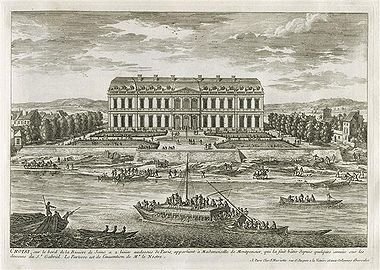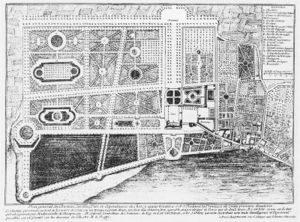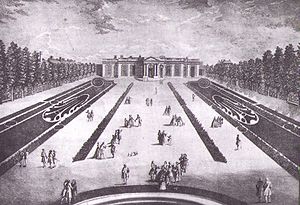
Château de Choisy
Encyclopedia

Choisy-le-Roi
Choisy-le-Roi is a commune in the southeastern suburbs of Paris, France. It is located from the center of Paris.-Geography:Crossed by the Seine river, it is located from the center of Paris....
in the Val-de-Marne
Val-de-Marne
Val-de-Marne is a French department, named after the Marne River, located in the Île-de-France region. The department is situated to the southeast of the city of Paris.- Geography :...
département, not far from Paris
Paris
Paris is the capital and largest city in France, situated on the river Seine, in northern France, at the heart of the Île-de-France region...
. The commune was given its present name by Louis XV
Louis XV of France
Louis XV was a Bourbon monarch who ruled as King of France and of Navarre from 1 September 1715 until his death. He succeeded his great-grandfather at the age of five, his first cousin Philippe II, Duke of Orléans, served as Regent of the kingdom until Louis's majority in 1723...
, when he purchased the manor of Choisy and its château in October 1739.
The Château of La Grande Mademoiselle
The site had been purchased well before 1680by Louis XIV's first cousin Anne-Marie-Louise d’Orléans, duchesse de MontpensierAnne, Duchess of Montpensier
Anne Marie Louise d'Orléans, Duchess of Montpensier, known as La Grande Mademoiselle, was the eldest daughter of Gaston d'Orléans, and his first wife Marie de Bourbon. One of the greatest heiresses in history, she died unmarried and childless, leaving her vast fortune to her cousin, Philippe of...
, "La Grande Mademoiselle". She laid out 40,000 livres for the property, and swept away quite a pretty existing corps de logis
Corps de logis
Corps de logis is the architectural term which refers to the principal block of a large, usually classical, mansion or palace. It contains the principal rooms, state apartments and an entry. The grandest and finest rooms are often on the first floor above the ground level: this floor is the...
, according to her Mémoires, and had a new house built to plans of Jacques Gabriel
Jacques Gabriel
Jacques Gabriel was a French architect, the father of the famous Ange-Jacques Gabriel.His mother was a cousin of Jules Hardouin-Mansart and his father, another Jacques Gabriel was a masonry contractor for the Bâtiments du Roi, the French royal works, and the designer of the Château de Choisy for...
—"who made my house to my fashion" Mlle Montpensier noted, "without any ornament or 'architecture'" an assertion that overlooked sculptural enrichments in the pediment, by Étienne Le Hongre
Etienne Le Hongre
Etienne Le Hongre was a French sculptor, part of the team that worked for the Bâtiments du Roi at Versailles. Le Hongre was one of the first generation of sculptors formed by the precepts of the Académie royale de peinture et de sculpture...
.
The Château de Choisy was set in an elaborate series of gardens laid out by André Le Nôtre
André Le Nôtre
André Le Nôtre was a French landscape architect and the principal gardener of King Louis XIV of France...
. He was called in before the few existing buildings were swept away and found the site too closed in by woodland: "There one only saw the riverbank as if through a dormer window," he told the king—who passed on the remark— and advised Mlle de Montpensier to begin in this "vilaine situation" by "laying low all the woods that were there". The view of the river was the main thing, and Mlle de Montpensier calculated it to advantage: "As I had my house built in order to go there in summer, I took measures in order that one might see the river in the time of year when it is at its lowest; from my bed I see it and all the boats that pass."

Pierre-Jean Mariette
Pierre-Jean Mariette was a collector of and dealer in old master prints, a renowned connoisseur, especially of prints and drawings, and a chronicler of the careers of French Italian and Flemish artists...
, Gabriel Pérelle and Pierre Aveline. Its interiors were well described in the Grande Mademoiselle's Mémoires.
The château passed in 1693 to le Grand Dauphin, who had some interior modifications executed (Kimball 1943 p 51) before exchanging it in 1695 for Meudon
Meudon
Meudon is a municipality in the southwestern suburbs of Paris, France. It is in the département of Hauts-de-Seine. It is located from the center of Paris.-Geography:...
, more accessible from Versailles.
After Louis XIV
In 1716, it was sold to Marie Anne de BourbonMarie Anne de Bourbon
Marie Anne de Bourbon, Légitimée de France was the eldest legitimised daughter of King Louis XIV of France and Louise de La Vallière. At the age of thirteen, she was married to Louis Armand de Bourbon, Prince of Conti and as such was the Princess of Conti by marriage...
(1666-1739), dowager princess de Conti, the legitimised daughter of Louis XIV and Louise de la Vallière
Louise de La Vallière
Louise de La Vallière was a mistress of Louis XIV of France from 1661 to 1667. She later became the Duchess of La Vallière and Duchess of Vaujours in her own right...
.
In spite of the loss of the immediately surrounding woods in favor of parterre
Parterre
A parterre is a formal garden construction on a level surface consisting of planting beds, edged in stone or tightly clipped hedging, and gravel paths arranged to form a pleasing, usually symmetrical pattern. Parterres need not have any flowers at all...
s with the Seine as backdrop and bosquet
Bosquet
In the French formal garden, a bosquet is a formal plantation of trees, at least five of identical species planted as a quincunx, or set in strict regularity as to rank and file, so that the trunks line up as one passes along either face...
s punctuated by statuary, the hunting was good in the neighboring forest of Sénart, the king's original motivation for purchasing Choisy. The king enlarged the château from 1740 onwards, under the direction of Ange-Jacques Gabriel
Ange-Jacques Gabriel
Ange-Jacques Gabriel was the most prominent French architect of his generation.Born to a Parisian family of architects and initially trained by the royal architect Robert de Cotte and his father , whom he assisted in the creation of the Place Royale at Bordeaux , the younger Gabriel...
, premier architecte du Roi. He was able to use Choisy by 1741. The central block was doubled in depth in the modern way; a theatre was added and the stables were greatly enlarged; Mlle de Montpesier's belle orangerie was rebuilt and in its central salon Edmé Bouchardon
Edmé Bouchardon
Edmé Bouchardon was a French sculptor, esteemed in his day as the greatest sculptor of his time and valued as a draughtsman as well.-Biography:...
's Love shaping his bow from the club of Hercules was installed in 1752. A bathing pavilion was added, and above all a Petit Château (illustration, right) was designed to provide an intimate refuge for Louis XV and Madame de Pompadour
Madame de Pompadour
Jeanne Antoinette Poisson, Marquise de Pompadour, also known as Madame de Pompadour was a member of the French court, and was the official chief mistress of Louis XV from 1745 to her death.-Biography:...
. Works continued in a series of campaigns as late as 1777, though Louis XV lost interest in Choisy after Pompadour's death, but there is precious little documentation of the interiors, save a section by Gabriel, dated 1754, of the circular Salon and Vestibule in the Pavillon Particulier du Roi, the Petit Château: "it shows a sober character' Fiske Kimball reported: 'the overdoor is an unbroken oval crowned with shellwork and scrolls, but draped...with the newly fashionable garland of husks" (Kimball p 207).

Ébéniste
Ébéniste is the French word for a cabinetmaker, whereas in French menuisier denotes a woodcarver or chairmaker. The English equivalent for "ébéniste," "ebonist," is never commonly used. Originally, an ébéniste was one who worked with ebony, a favoured luxury wood for mid-seventeenth century...
Antoine Gaudreau
Antoine Gaudreau
Antoine-Robert Gaudreau was a Parisian ébéniste who was appointed Ébéniste du Roi and was the principal supplier of furniture for the royal châteaux during the early years of Louis XV's reign. He is largely known through the copious documentation of the Garde-Meuble de la Couronne; he entered the...
in 1744 though it bears gilt-bronze mounts, is no grander than the writing tables of many a contemporaneous aristocrat. Chardin provided emblemmatic still lives free of rhetoric or pomp, as overdoor
Overdoor
An "overdoor" is a painting, bas-relief or decorative panel, generally in a horizontal format, that is set, typically within ornamental mouldings, over a door, or was originally intended for this purpose.The overdoor is usually architectural in form, but may take the form of a cartouche in Rococo...
s for an unidentified room, in 1765. Lambert Sigisbert Adam was less than lucky, however, with his marble bust of Louis XV as Apollo, dated 1749, which Adam had shown at the Salon of 1745 and which, on his own initiative, he placed in the Galerie at Choisy, which was to be decorated by Charles Parrocel with a series of decorative Conquests of Louis XV. The project, perhaps too grandiose for the royal retreat, came to nothing, and Adam overreached himself in asking 7000 louis for the bust; the king's reaction in September 1762 was that he did not want to see it at Choisy on his next visit and that Adam should pack it up and remove it.
The surrounding parish received an influx of business due to the royal presence, and a new parish church. For fête
Fête
Fête is a French word meaning festival, celebration or party, which has passed into English as a label that may be given to certain events.-Description:It is widely used in England and Australia in the context of a village fête,...
s on the river at Choisy, the king had gondola
Gondola
The gondola is a traditional, flat-bottomed Venetian rowing boat, well suited to the conditions of the Venetian Lagoon. For centuries gondolas were the chief means of transportation and most common watercraft within Venice. In modern times the iconic boats still have a role in public transport in...
s imported from Venice.
After Louis XV
After the king's death, Marie AntoinetteMarie Antoinette
Marie Antoinette ; 2 November 1755 – 16 October 1793) was an Archduchess of Austria and the Queen of France and of Navarre. She was the fifteenth and penultimate child of Holy Roman Empress Maria Theresa and Holy Roman Emperor Francis I....
came often to Choisy, though at the time of the purchase of the Château de Saint-Cloud
Saint-Cloud
Saint-Cloud is a commune in the western suburbs of Paris, France. It is located from the centre of Paris.Like other communes of the Hauts-de-Seine such as Marnes-la-Coquette, Neuilly-sur-Seine or Vaucresson, Saint-Cloud is one of the wealthiest cities in France, ranked 22nd out of the 36500 in...
from the Orléans, it was briefly suggested that Choisy be part of the exchange. Louis XV installed at Choisy the portrait he commissioned from Drouais
François-Hubert Drouais
François-Hubert Drouais was a French painter and the father of Jean-Germain Drouais.Drouais was born and died in Paris. He specialized in portraits of the French nobility, foreign aristocrats, writers, and other artists. Some of his portraits include Louis XV's last two mistresses, Madame de...
of Marie Antoinette as Dauphine, in 1773 In 1777, when the Queen wished to build at Versailles a little theatre for private performances in which she joined, she instructed the architect Richard Mique
Richard Mique
Richard Mique was a neoclassical French architect born in Lorraine. He is most remembered for his picturesque hamlet, the Hameau de la reine — not particularly characteristic of his working style — for Marie Antoinette in the Petit Trianon gardens within the estate of Palace of...
to take for his model the theatre at Choisy built by Gabriel for Mme de Pompadour; as a result, the theatre, finished in 1779, though it is modest and fully Neoclassical on the outside, has an interior unexpectedly rococo for its date.
The château and the petit château were royal residences; thus at the Revolution
French Revolution
The French Revolution , sometimes distinguished as the 'Great French Revolution' , was a period of radical social and political upheaval in France and Europe. The absolute monarchy that had ruled France for centuries collapsed in three years...
, when the commune became Choisy-sur-Seine, the château was confiscated as a bien national, emptied of its contents at auctions (part of the Revolutionary sales), its terrains divided into individual lots and sold. The buildings fell into disrepair and were demolished bit by bit during the nineteenth century. Today all that remains are a dry ditch and ha-ha and two pavilions flanking the former cour d'honneur
Cour d'Honneur
Cour d'Honneur is the architectural term for defining a three-sided courtyard, created when the main central block, or corps de logis, is flanked by symmetrical advancing secondary wings, containing minor rooms...
, and a range of the former service wing.
Further reading
- B. Champchine, Le château de Choisy (Paris) 1910.

